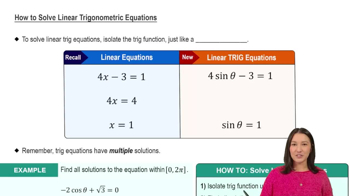Here are the essential concepts you must grasp in order to answer the question correctly.
Tangent Function
The tangent function, denoted as tan(x), is a fundamental trigonometric function defined as the ratio of the opposite side to the adjacent side in a right triangle. It is periodic with a period of π, meaning it repeats its values every π radians. Understanding the behavior of the tangent function, including its asymptotes and where it is positive or negative, is crucial for solving equations involving tan(x).
Recommended video:
Introduction to Tangent Graph
Inverse Trigonometric Functions
Inverse trigonometric functions, such as arctan, are used to find angles when the value of a trigonometric function is known. For example, if tan(x) = -3, we can use arctan(-3) to find the reference angle. However, since the tangent function is periodic, we must consider all possible angles within the specified interval, which in this case is [0, 2π).
Recommended video:
Introduction to Inverse Trig Functions
Calculator Usage for Trigonometric Equations
Using a calculator to solve trigonometric equations involves inputting the equation correctly and understanding the settings, such as whether the calculator is in degree or radian mode. For the equation tan(x) = -3, the calculator will provide a principal value, but additional solutions must be found by considering the periodic nature of the tangent function and the specified interval [0, 2π).
Recommended video:
How to Solve Linear Trigonometric Equations
 Verified step by step guidance
Verified step by step guidance Verified Solution
Verified Solution



 4:25m
4:25m